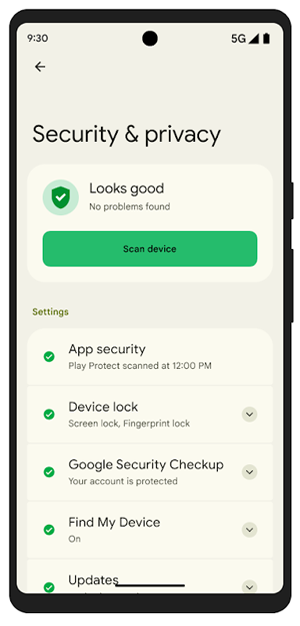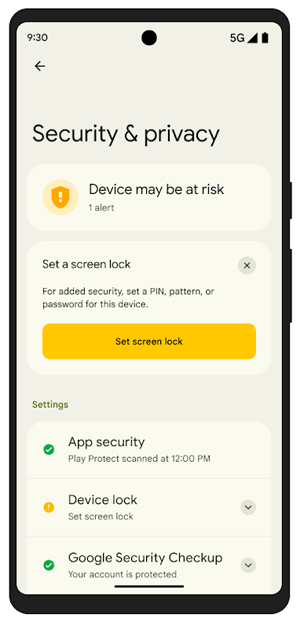ศูนย์ความปลอดภัยของ Android ซึ่งเปิดตัวใน Android 13 ทำหน้าที่เป็นฮับส่วนกลาง สำหรับการจัดการการตั้งค่าความปลอดภัยและความเป็นส่วนตัวของอุปกรณ์ โดยจะรวม ฟีเจอร์ต่างๆ เช่น การตั้งค่าหน้าจอล็อก ข้อมูลไบโอเมตริก การอัปเดตความปลอดภัย แอปหาอุปกรณ์ของฉัน, Google Play Protect และการตรวจเช็คความปลอดภัยของบัญชี Google ไว้ในหน้าเดียว ศูนย์ความปลอดภัยไม่เพียงแต่มี รายการเปลี่ยนเส้นทางไปยังการตั้งค่าแต่ละรายการเหล่านี้ แต่ยังระบุปัญหาหรือความเสี่ยงที่อาจเกิดขึ้นในอุปกรณ์หรือบัญชีของคุณเชิงรุกด้วยการรวม ข้อมูลแบบไดนามิกจากหลายแหล่งที่มา พร้อมให้คำแนะนำที่นำไปใช้ได้จริงเพื่อ เพิ่มความปลอดภัยและความเป็นส่วนตัว ซึ่งจะช่วยให้กระบวนการรักษาความปลอดภัยและรับทราบข้อมูลเกี่ยวกับท่าทางด้านความปลอดภัยของอุปกรณ์ Android เป็นไปอย่างราบรื่น


รูปที่ 1 หน้าจอศูนย์ความปลอดภัย
แหล่งที่มาของศูนย์ความปลอดภัย
แหล่งที่มาของศูนย์ความปลอดภัยจะให้ข้อมูลแก่ศูนย์ความปลอดภัย โดยทั่วไปแล้วแหล่งที่มาจะเป็นของแอปอื่นในอุปกรณ์ อนุญาตเฉพาะแอปของระบบ แหล่งที่มาที่ปลอดภัย แอปของบุคคลที่สามไม่ใช่แหล่งข้อมูลด้านความปลอดภัย
ตัวอย่างแหล่งข้อมูลในศูนย์ความปลอดภัยมีดังนี้
- ล็อกหน้าจอ
- ข้อมูลไบโอเมตริก
- การอัปเดตความปลอดภัย
- หาอุปกรณ์ของฉัน
- Google Play Protect
- การตรวจสอบความปลอดภัยของบัญชี Google
- สัญญาณความเป็นส่วนตัว
แหล่งข้อมูลของศูนย์ความปลอดภัยสามารถให้ข้อมูลประเภทต่อไปนี้
- รายการใน UI ของศูนย์ความปลอดภัยเพื่อเปลี่ยนเส้นทางผู้ใช้ไปยังหน้าจออื่น รายการนี้มีสถานะที่แสดงว่าผู้ใช้มีความเสี่ยงหรือไม่ พร้อมด้วย ข้อมูลเมตาเพิ่มเติมที่เชื่อมโยงกับสถานะ เช่น ชื่อและ ข้อมูลสรุป
- การ์ดคำเตือน (หรือที่เรียกว่าปัญหา) ที่แก้ไขได้โดยตรงจากศูนย์ความปลอดภัย หรือโดยการเปลี่ยนเส้นทางผู้ใช้ไปยังหน้าจออื่น นอกจากนี้ ปัญหาแต่ละรายการยังมีข้อมูลเมตาเพิ่มเติมที่เชื่อมโยงอยู่ด้วย เช่น ชื่อ สรุป ป้ายกำกับปุ่ม และการดำเนินการ
- ข้อผิดพลาดที่อาจเกิดขึ้นเมื่อพยายามให้ข้อมูลแก่ศูนย์ความปลอดภัย
- เหตุผลที่แหล่งที่มาส่งข้อมูลไปยังศูนย์ความปลอดภัย
พาร์ทเนอร์สามารถใช้ เอกสารเฉพาะพาร์ทเนอร์

